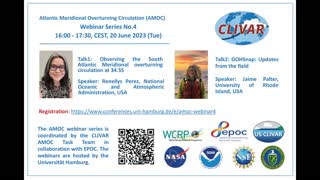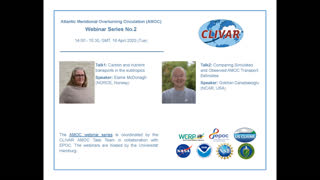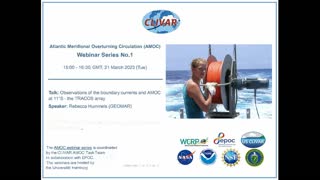Carbon and nutrient transports in the subtropics & How do we improve observational-based estimates and model representations of AMOC? - Dr. Gokhan Danabasoglu, Prof. Elaine McDonagh - University of Hamburg
- Lecture2Go
- Catalog
- F.6 - Mathematik, Informatik, Naturwissenschaften
- Sonstiges
- AMOC Webinar Series
Catalog
1360 Views
18.04.2023
Carbon and nutrient transports in the subtropics & How do we improve observational-based estimates and model representations of AMOC?
Title: Carbon and nutrient transports in the subtropics
Speaker: Elaine McDonagh (NORCE, Norway)
Slides: https://doi.org/10.5281/zenodo.7845013
Abstract:
As a result of the AMOC the North Atlantic absorbs a disproportionately large amount of carbon for its area. Using observations from RAPID-MOCHA, Argo and GO-SHIP at 26N we reconstruct time series of anthropogenic carbon and inorganic nutrient transports into the North Atlantic. On average half of the anthropogenic carbon that is accumulating in the North Atlantic is transported into the region across 26N, the remainder comes from local air-sea fluxes. While most of the variance in the northward anthropogenic carbon transport can be described by variability in the strength of the AMOC there is a significant contribution form the increasing anthropogenic carbon concentrations, preferentially accumulating in the near-surface. The persistently southward nutrient transports across 26N exceed external nutrient sources and thus in themselves indicate non steady-state behaviour. In addition increasing remineralised:preformed nutrient ratios at 26N indicate further non steady-state behavoiur and regionally increasing biological carbon pump efficiency consistent with a transient response to circulation changes.
Title: How do we improve observational-based estimates and model representations of AMOC?
Speaker: Gokhan Danabasoglu (NCAR, USA)
Slides: https://doi.org/10.5281/zenodo.7845078
Abstract:
Joint and consistent analysis of model simulations and observations of the Atlantic Meridional Overturning Circulation (AMOC) is important to advance our understanding of its trends, variability, and mechanisms as well as its latitudinal coherency. It is important that such model – observations comparisons use the same or as-close-as-practically-possible methods as applied in observations to provide apples-to-apples comparisons. Considering the Meridional Overturning Variability Experiment (MOVE) array at 16°N, the RAPID Array at 26.5°N, the South Atlantic MOC Basin-wide Array (SAMBA) at 34.5°S, and the Overturning in the Subpolar North Atlantic Program (OSNAP) array at 57°N, we revisit the underlying assumptions used to calculate their respective transports in comparison to transports from an eddying ocean hindcast simulation where transports obtained using the same observational methods can be directly compared against model truth. Our analysis reveals significant sensitivity of simulated and observed transports and their variability and trends to various reference level assumptions. Indeed, given i) the short observational records, ii) strong dependencies of transport estimates to their barotropic / compensating components, and iii) the presence of large interannual-to-decadal timescale variability, whether AMOC has been declining or not during the last couple of decades cannot be meaningfully determined. In general, simulated variability is weaker than in observations, particularly for the 9-site SAMBA estimate. We show reasons for these differences, considering contributions of transport components and the underlying transport assumptions associated with the observational methods. We also discuss complementarity of depth- and density-space AMOC depictions.
---
The AMOC ( Atlantic Meridional Overturning Circulation) Webinar Series gives an overview and assessments of the current AMOC observing systems. Overview: https://www.clivar.org/amoc-webinar-series Workshop on Meeting AMOC Observation Needs in a Changing Climate: https://www.clivar.org/events/workshop-meeting-... The AMOC Webinar Series is organised by the CLIVAR AMOC Task Team in collaboration with the EU-Project EPOC, coordinated at the UHH.
---
The AMOC ( Atlantic Meridional Overturning Circulation) Webinar Series gives an overview and assessments of the current AMOC observing systems. Overview: https://www.clivar.org/amoc-webinar-series Workshop on Meeting AMOC Observation Needs in a Changing Climate: https://www.clivar.org/events/workshop-meeting-... The AMOC Webinar Series is organised by the CLIVAR AMOC Task Team in collaboration with the EU-Project EPOC, coordinated at the UHH.
Technical support
Please click on the link bellow and then fill out the required fields to contact our Support Team!
RRZ Support Link




